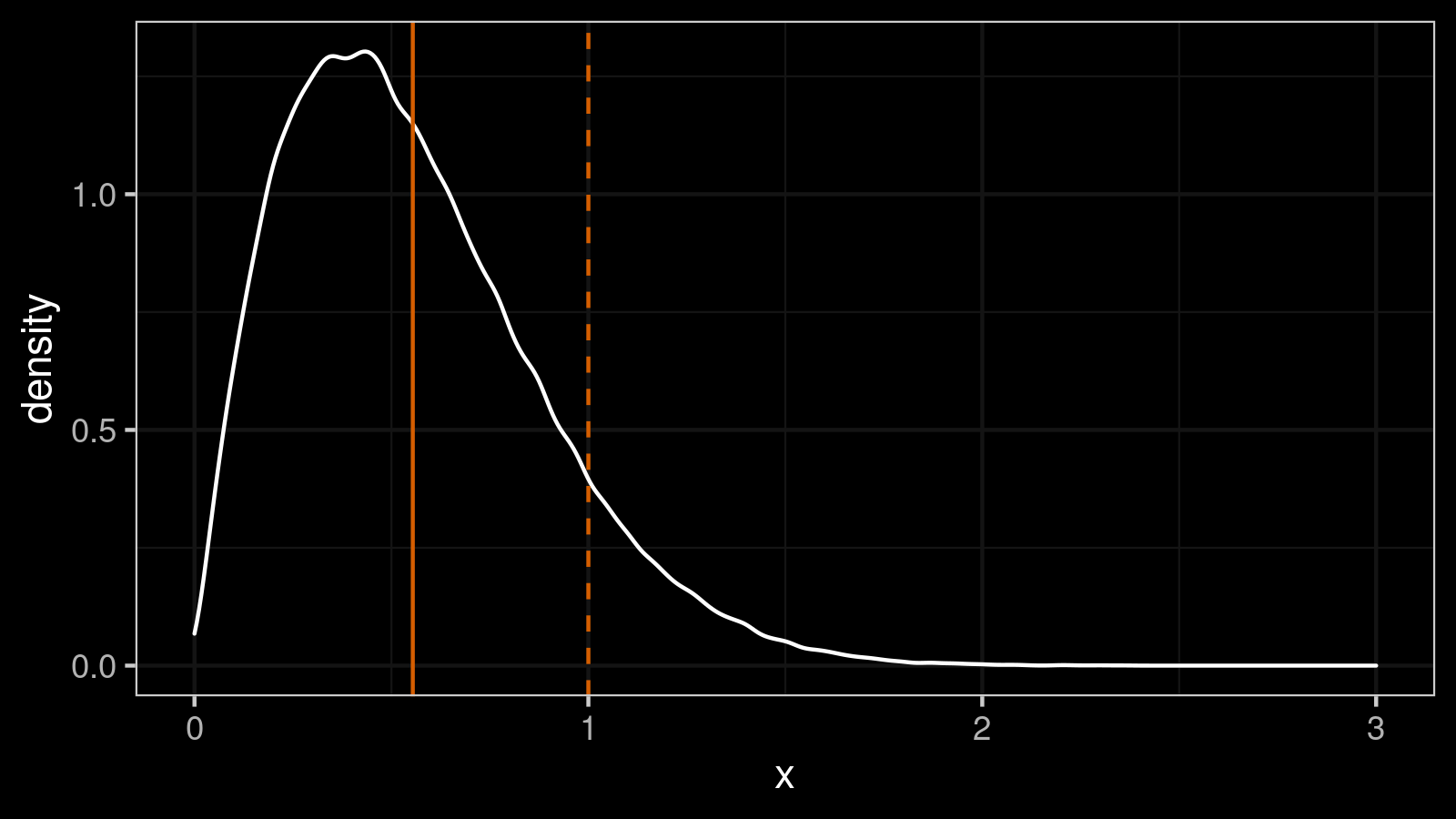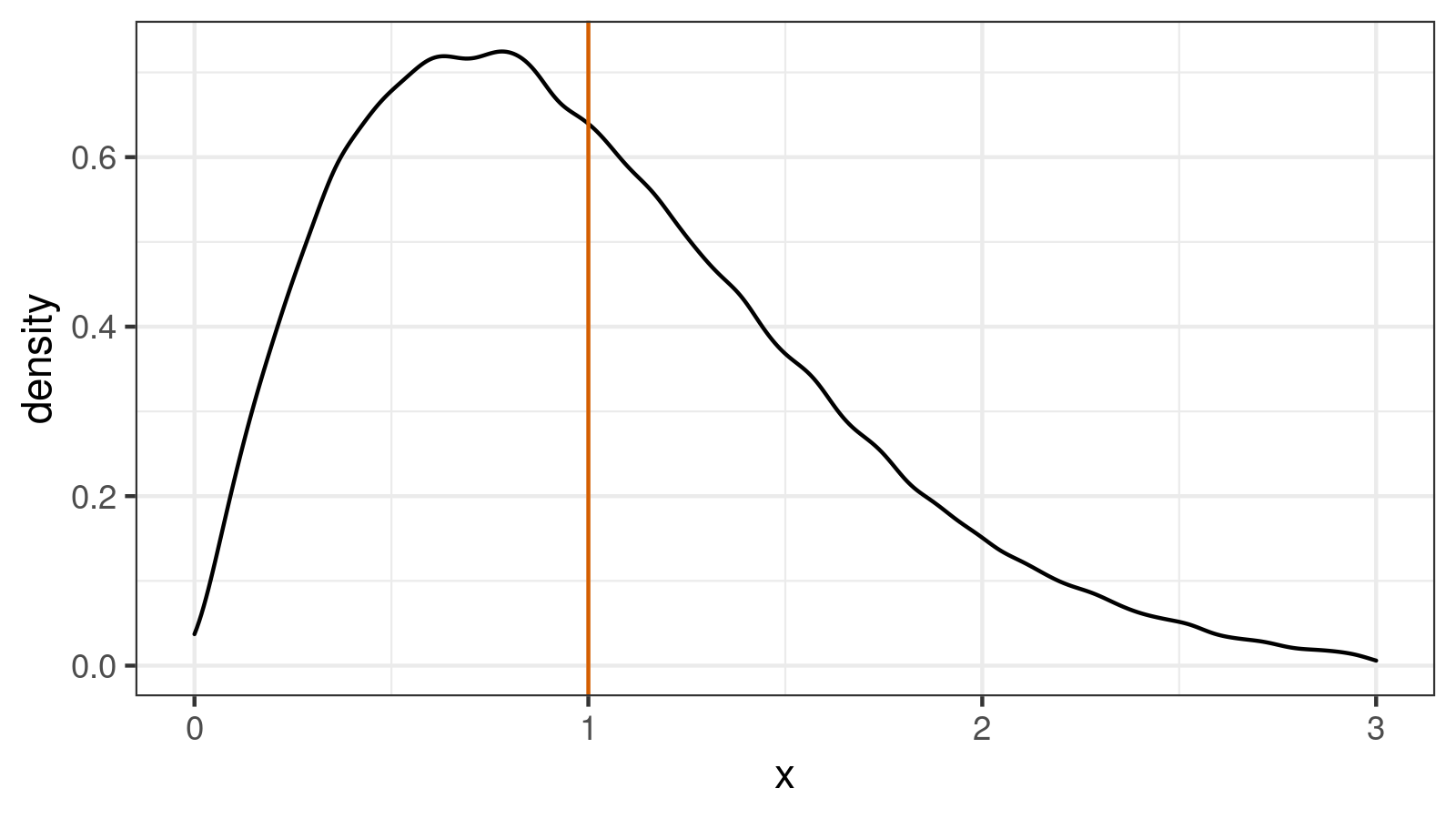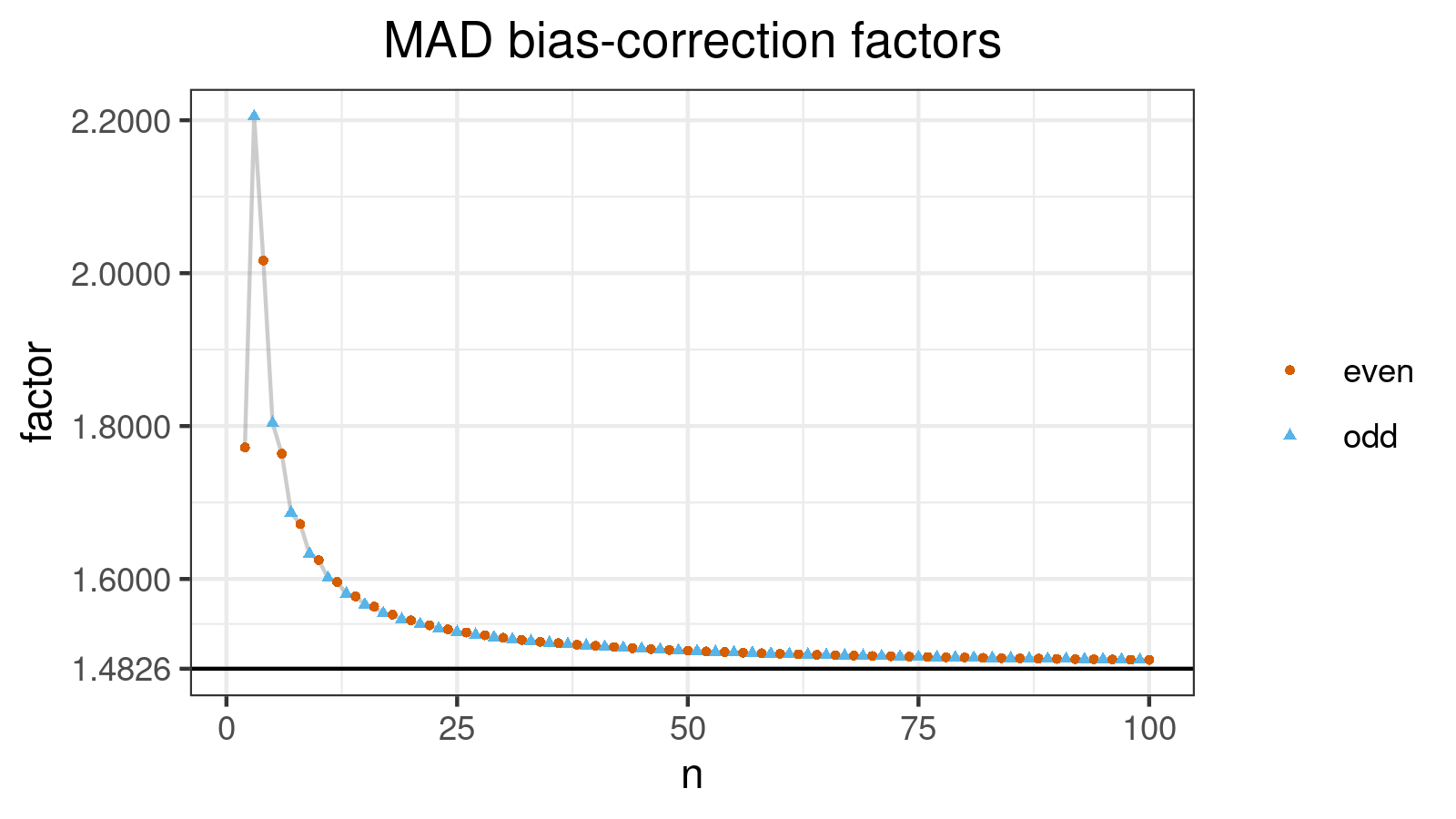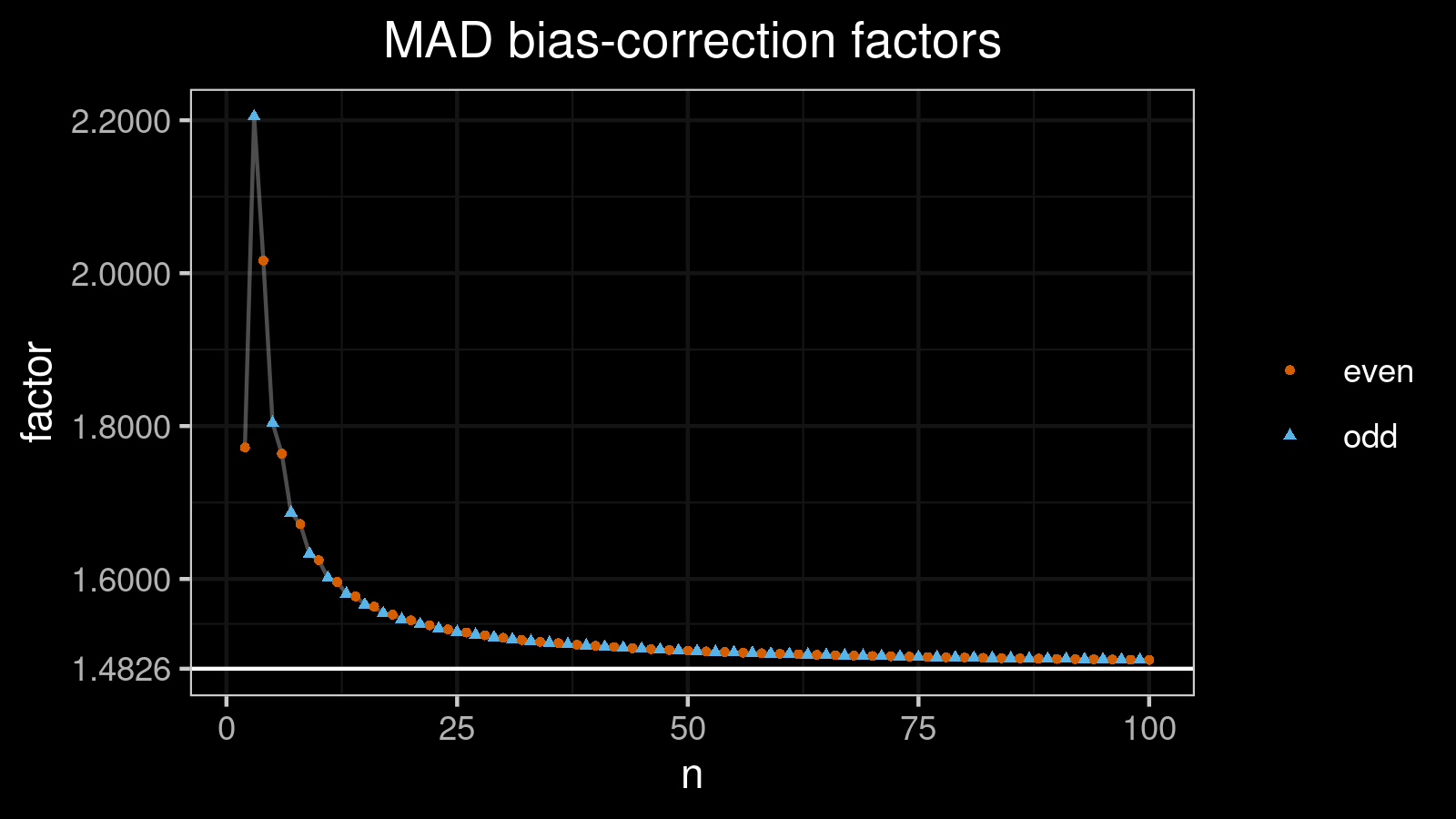Unbiased median absolute deviation
The below text contains an intermediate snapshot of the research and is preserved for historical purposes.
The median absolute deviation ($\textrm{MAD}$) is a robust measure of scale. For distribution $X$, it can be calculated as follows:
$$ \textrm{MAD} = C \cdot \textrm{median}(|X - \textrm{median}(X)|) $$where $C$ is a constant scale factor. This metric can be used as a robust alternative to the standard deviation. If we want to use the $\textrm{MAD}$ as a consistent estimator for the standard deviation under the normal distribution, we should set
$$ C = C_{\infty} = \dfrac{1}{\Phi^{-1}(3/4)} \approx 1.4826022185056. $$where $\Phi^{-1}$ is the quantile function of the standard normal distribution (or the inverse of the cumulative distribution function). If $X$ is the normal distribution, we get $\textrm{MAD} = \sigma$ where $\sigma$ is the standard deviation.
Now let’s consider a sample $x = \{ x_1, x_2, \ldots x_n \}$. Let’s denote the median absolute deviation for a sample of size $n$ as $\textrm{MAD}_n$. The corresponding equation looks similar to the definition of $\textrm{MAD}$ for a distribution:
$$ \textrm{MAD}_n = C_n \cdot \textrm{median}(|x - \textrm{median}(x)|). $$Let’s assume that $\textrm{median}$ is the straightforward definition of the median (if $n$ is odd, the median is the middle element of the sorted sample, if $n$ is even, the median is the arithmetic average of the two middle elements of the sorted sample). We still can use $C_n = C_{\infty}$ for extremely large sample sizes. However, for small $n$, $\textrm{MAD}_n$ becomes a biased estimator. If we want to get an unbiased version, we should adjust the value of $C_n$.
In this post, we look at the possible approaches and learn the way to get the exact value of $C_n$ that makes $\textrm{MAD}_n$ unbiased estimator of the median absolute deviation for any $n$.
The bias
Let’s briefly discuss the impact of the bias on our measurements. To illustrate the problem, we take $100\,000$ samples of size $n = 5$ from the standard normal distribution and calculate $\textrm{MAD}_5$ for each of them using $C = 1$. The obtained numbers form the following distribution:
If we try to use $\textrm{MAD}_5$ with $C = 1$ as a standard deviation estimator, it would be a biased estimator. Indeed, the standard deviation equals $1$ (the true value), but the expected value of $\textrm{MAD}_5$ is about $E[\textrm{MAD}_5] \approx 0.5542$. In order to make it unbiased, we should set $C_5 = 1 / 0.5542 \approx 1.804$. If we repeat the experiment with the modified scale factor, we get a modified version of our distribution:
Now $E[\textrm{MAD}_5] \approx 1$ which makes $\textrm{MAD}_5$ unbiased estimator.
Note that $C_5 = 1.804$ differs from $C_{\infty} \approx 1.4826$ which is the proper scale factor for $n \to \infty$. Each sample size needs its own scale factor to make $\textrm{MAD}_n$ unbiased. Let’s review some papers and look at different approaches to find the optimal scale factor value.
Literature overview
One of the first mentions of the median absolute deviation can be found in The influence curve and its role in robust estimation
By Frank R Hampel
·
1974hampel1974.
In this paper, Frank R Hampel introduced $\textrm{MAD}$ as a robust measure of scale
(attributed to Gauss).
I have found four papers that describe unbiased versions:
Time-Efficient Algorithms for Two Highly Robust Estimators of Scale
By Christophe Croux, Peter J Rousseeuw, Yadolah Dodge, Joe Whittaker
·
1992croux1992, Finite sample correction factors for several simple robust estimators of normal standard deviation
By Dennis C Williams
·
2011williams2011, Finite-Sample Bias-Correction Factors for the Median Absolute Deviation
By Kevin Hayes
·
2014hayes2014, and Investigation of finite-sample properties of robust location and scale estimators
By Chanseok Park, Haewon Kim, Min Wang
·
2020park2020.
Let’s briefly discuss approaches from these papers.
The Croux-Rousseeuw approach
In Time-Efficient Algorithms for Two Highly Robust Estimators of Scale
By Christophe Croux, Peter J Rousseeuw, Yadolah Dodge, Joe Whittaker
·
1992croux1992, Christophe Croux and Peter J. Rousseeuw
described an unbiased version of $\textrm{MAD}$.
They suggested using the following equations:
For $n \leq 9$, the approximated values of $b_n$ were defined as follows:
| n | $b_n$ |
|---|---|
| 2 | 1.196 |
| 3 | 1.495 |
| 4 | 1.363 |
| 5 | 1.206 |
| 6 | 1.200 |
| 7 | 1.140 |
| 8 | 1.129 |
| 9 | 1.107 |
For $n > 9$, they suggested to use the following equation:
$$ b_n = \dfrac{n}{n-0.8}. $$The Williams approach
In Finite sample correction factors for several simple robust estimators of normal standard deviation
By Dennis C Williams
·
2011williams2011, Dennis C. Williams improved this approach.
Firstly, he provided updated $b_n$ values for small $n$:
| n | $b_n$ by Croux | $b_n$ by Williams |
|---|---|---|
| 2 | 1.196 | 1.197 |
| 3 | 1.495 | 1.490 |
| 4 | 1.363 | 1.360 |
| 5 | 1.206 | 1.217 |
| 6 | 1.200 | 1.189 |
| 7 | 1.140 | 1.138 |
| 8 | 1.129 | 1.127 |
| 9 | 1.107 | 1.101 |
Secondly, he also introduced a small correction for the general equation:
$$ b_n = \dfrac{n}{n-0.801}. $$Also, he discussed another kind of approximation equation for such kind of bias-correction factors:
$$ b_n \cong 1 + cn^{-d}. $$In his paper, he applied the above equation only to Shorth (which is the smallest interval that contains at least half of the data points), but this approach can also be applied to other measures of scale.
The Hayes approach
Next, in Finite-Sample Bias-Correction Factors for the Median Absolute Deviation
By Kevin Hayes
·
2014hayes2014, Kevin Hayes suggested another kind of prediction equation for $n \geq 9$:
where
$$ \hat{a}_n = \Phi^{-1}(3/4) \Bigg( 1 - \dfrac{\alpha}{n} - \dfrac{\beta}{n^2} \Bigg). $$Here are the suggested constants:
| n | $\alpha$ | $\beta$ |
|---|---|---|
| odd | 0.7635 | 0.565 |
| even | 0.7612 | 1.123 |
The Park-Kim-Wang approach
Finally, in Investigation of finite-sample properties of robust location and scale estimators
By Chanseok Park, Haewon Kim, Min Wang
·
2020park2020, Chanseok Park, Haewon Kim, and Min Wang aggregated all of the previous results.
They used the following form of the main equation:
For $n > 100$, they suggested two approaches.
The first one is based on Finite-Sample Bias-Correction Factors for the Median Absolute Deviation
By Kevin Hayes
·
2014hayes2014 (the same equation for both odd and even $n$ values):
The second one is based on Finite sample correction factors for several simple robust estimators of normal standard deviation
By Dennis C Williams
·
2011williams2011:
Both approaches produce almost identical results, so it doesn’t actually matter which one to use.
For $2 \leq n \leq 100$, they suggested to use predefined constants:
(the below values are based on Table A2 from Investigation of finite-sample properties of robust location and scale estimators
By Chanseok Park, Haewon Kim, Min Wang
·
2020park2020):
| n | $C_n$ | n | $C_n$ |
|---|---|---|---|
| 1 | NA | 51 | 1.505611 |
| 2 | 1.772150 | 52 | 1.505172 |
| 3 | 2.204907 | 53 | 1.504575 |
| 4 | 2.016673 | 54 | 1.504417 |
| 5 | 1.803927 | 55 | 1.503713 |
| 6 | 1.763788 | 56 | 1.503604 |
| 7 | 1.686813 | 57 | 1.503095 |
| 8 | 1.671843 | 58 | 1.502864 |
| 9 | 1.632940 | 59 | 1.502253 |
| 10 | 1.624681 | 60 | 1.502085 |
| 11 | 1.601308 | 61 | 1.501611 |
| 12 | 1.596155 | 62 | 1.501460 |
| 13 | 1.580754 | 63 | 1.501019 |
| 14 | 1.577272 | 64 | 1.500841 |
| 15 | 1.566339 | 65 | 1.500331 |
| 16 | 1.563769 | 66 | 1.500343 |
| 17 | 1.555284 | 67 | 1.499877 |
| 18 | 1.553370 | 68 | 1.499772 |
| 19 | 1.547206 | 69 | 1.499291 |
| 20 | 1.545705 | 70 | 1.499216 |
| 21 | 1.540681 | 71 | 1.498922 |
| 22 | 1.539302 | 72 | 1.498838 |
| 23 | 1.535165 | 73 | 1.498491 |
| 24 | 1.534053 | 74 | 1.498399 |
| 25 | 1.530517 | 75 | 1.497917 |
| 26 | 1.529996 | 76 | 1.497901 |
| 27 | 1.526916 | 77 | 1.497489 |
| 28 | 1.526422 | 78 | 1.497544 |
| 29 | 1.523608 | 79 | 1.497248 |
| 30 | 1.523031 | 80 | 1.497185 |
| 31 | 1.520732 | 81 | 1.496797 |
| 32 | 1.520333 | 82 | 1.496779 |
| 33 | 1.518509 | 83 | 1.496428 |
| 34 | 1.517941 | 84 | 1.496501 |
| 35 | 1.516279 | 85 | 1.496295 |
| 36 | 1.516070 | 86 | 1.496089 |
| 37 | 1.514425 | 87 | 1.495794 |
| 38 | 1.513989 | 88 | 1.495796 |
| 39 | 1.512747 | 89 | 1.495557 |
| 40 | 1.512418 | 90 | 1.495420 |
| 41 | 1.511078 | 91 | 1.495270 |
| 42 | 1.511041 | 92 | 1.495141 |
| 43 | 1.509858 | 93 | 1.494944 |
| 44 | 1.509499 | 94 | 1.494958 |
| 45 | 1.508529 | 95 | 1.494706 |
| 46 | 1.508365 | 96 | 1.494665 |
| 47 | 1.507535 | 97 | 1.494379 |
| 48 | 1.507247 | 98 | 1.494331 |
| 49 | 1.506382 | 99 | 1.494113 |
| 50 | 1.506307 | 100 | 1.494199 |
Here is the corresponding plot:
Conclusion
Currently, my tool-of-choice is the approach from Investigation of finite-sample properties of robust location and scale estimators
By Chanseok Park, Haewon Kim, Min Wang
·
2020park2020].
I verified all the predefined constants and equations from the paper using numerical simulations.
I can confirm that the suggested approach produces
a reliable estimate of the unbiased median absolute deviation $\textrm{MAD}_n$.
References
- [Hampel1974]
Hampel, Frank R. “The influence curve and its role in robust estimation.” Journal of the american statistical association 69, no. 346 (1974): 383-393.
https://doi.org/10.2307/2285666 - [Croux1992]
Croux, Christophe, and Peter J. Rousseeuw. “Time-efficient algorithms for two highly robust estimators of scale.“In Computational statistics, pp. 411-428. Physica, Heidelberg, 1992.
https://doi.org/10.1007/978-3-662-26811-7_58 - [Williams2011]
Williams, Dennis C. “Finite sample correction factors for several simple robust estimators of normal standard deviation.” Journal of Statistical Computation and Simulation 81, no. 11 (2011): 1697-1702.
https://doi.org/10.1080/00949655.2010.499516 - [Hayes2014]
Hayes, Kevin. “Finite-sample bias-correction factors for the median absolute deviation.” Communications in Statistics-Simulation and Computation 43, no. 10 (2014): 2205-2212.
https://doi.org/10.1080/03610918.2012.748913 - [Park2020]
Park, Chanseok, Haewon Kim, and Min Wang. “Investigation of finite-sample properties of robust location and scale estimators.” Communications in Statistics-Simulation and Computation (2020): 1-27.
https://doi.org/10.1080/03610918.2019.1699114





